High Altitude Balloon Flights Carrying HF Radio Telemetry.
Miniature HF telemetry transmitters attached to 'super pressure' balloons.
Lightweight 'tracker/telemetry' transmitters built following the concept of the QRP-Labs U3S transmitter. Some of the flights use a trimmed down QRP-Labs synthisizer kit to generate the transmitter's signal, and all run on a modified version of QRP-Labs U3S firmware.
Past flight summaries:
ZL1RS balloon flight "BB05" was launched at around 21:15 UTC on 24 April 2018. It completed:
the 1st circumnavigation of the earth on 08 May 2018
the 2nd circumnavigation of the earth on 23 May 2018
it appears to have gone down in the outhern Atlantic Ocean between South America and South Africa late on 28 or early on 29 May 2018. Tracking map and information at the QRP-Labs "BB05" flight page.
ZL1RS balloon flight "BB04" was launched at 20:45 UTC on 10 January 2018 and appears to have suffered a burst balloon about 4,400 km east of New Zealand after 3 days of flying.
ZL1RS balloon flight "BB03" was launched just after 17 UTC on 07 January 2018 and was lost in an area of bad weather 2,000 km east of New Zealand after 2 days of flying.
ZL1RS balloon flight "BB02" was launched at 17:45 UTC on 17 Dec 2017 and was lost in an area of bad weather in the southern Indian Ocean somewhere southeast of South Africa after 9 days of flying.
ZL1RS balloon flight "BB01" was launched at about 18 UTC on 07 Dec 2017 and appears to have come down in bad weather about 3,000 km west of Chile after 5 days of flying.
Balloon Flight BB05 information
BB05 was launched at 21:15 UTC on 24 April 2018. Over the next 6 weeks it flew almost 2.5 circuits of the earth before going down in the south Atlantic Ocean on 06 June 2018.
The tracker transmitter uses modified QRP-Labs U3S firmware running on an ATmega328 with a 16 MHz clock and a nominal 3.3V supply (so working out of spec). The board is a custom made PCB (thanks Mikael). This board uses a very cheap TCXO and GPS from China. Power output is 50mW. There are four 52 x 39mm solar cells powering the electonics via a 3V3 boost regulator. The antenna is a 20m dipole made from 5.26m of 0.15mm copper wire supported on 4 pound breaking strain "Dyneema" fishing line going up to the balloon, and 5.26m of 0.15mm wire dangling below the payload. The TX and solar cells weigh 14 grams, and the whole payload with antenna weighs about 16 grams. This flight uses a SBS-13 balloon inflated with about 10 grams of 'free lift'. The expected float altitude is around 13,000m ASL.
There is a tracking map and information at QRP-Labs - "BB05", however the 'battery' voltage is 'broken' (as explained below) and the 'temperature' readings are incorrect due to a different A-D reference used in the WSPR telemetry decyphering software. If the JT9 signal is decoded, the correct temperature can be found with the chart in the information about BB02 below. The numbers for 'GPS lock' and 'satellite' should both read 1, meaning GPS lock = OK, and the number of satellites in the fix is 8 or more. If either reading is 0 this means the GPS is 'in trouble' and the balloon's position and altitude should not be relied on.
The transmitter is sending WSPR and JT9 on the 20m band in a 10 minute cycle starting on the 4th minute (QRP-Labs U3S "Frame Start" parameter = 10 04).
minute 04 & 05 - standard WSPR frame and first part of the telemetry transmission
minute 06 & 07 - encoded WSPR frame and second part of the telemetry transmission ('channel 2')
minute 08 - JT9 identification message #CS #M6
minute 09 - JT9 telemetry message #A0 #A3 #AT
minute 10 - JT9 telemetry message #GS #AT
minute 11 - JT9 telemetry message #A0 #A3 #AT
minute 12 - JT9 telemetry message #GS #AT
minute 13 - calibration (Cal Time = 10 10)
minute 14 - repeat ...
The JT9 message #CS is the callsign (ZL1RS)
The JT9 message #M6 is the 6 character Maidenhead locator as derived from the GPS module on the transmitter
The JT9 message #A0 is the temperature A-D value and will probably be in the range 090 to 220 (approx. -21 to +21C). See the chart with the BB02 information below.
The JT9 message #A3 is supposed to be the solar voltage, but something broke and it sends "A17" every time ...
The JT9 message #GS is the ground speed value from the GPS
The JT9 message #AT is the altitude in meters above sea level from the GPS.
Typical decodes of the balloon telemetry as seen with WSJT-X and a receiver tuned to the 20m band WSPR 'dial frequency' of 14.0956 MHz (the JT9 signal can be found about 100 Hz above the WSPR signal) ...
WSPR:
2334 6 0.0 14.097180 2 ZL1RS RF75 10 141
2336 6 0.1 14.097181 2 0R2DPN IE58 30 11506
JT9:
2338 3 -0.9 1667 @ ZL1RS RF75SO
2339 1 -0.9 1667 @ 173 A17 13133
2340 2 -0.9 1668 @ 119.32 13135.
2341 1 -0.9 1667 @ 175 A17 13129
2342 1 -0.9 1667 @ 118.78 13127.
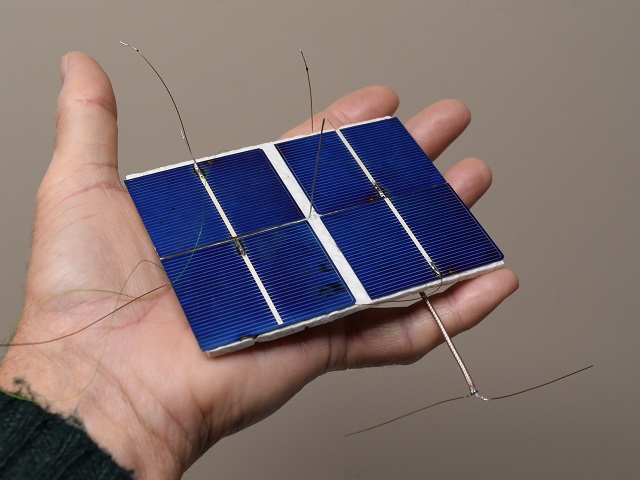
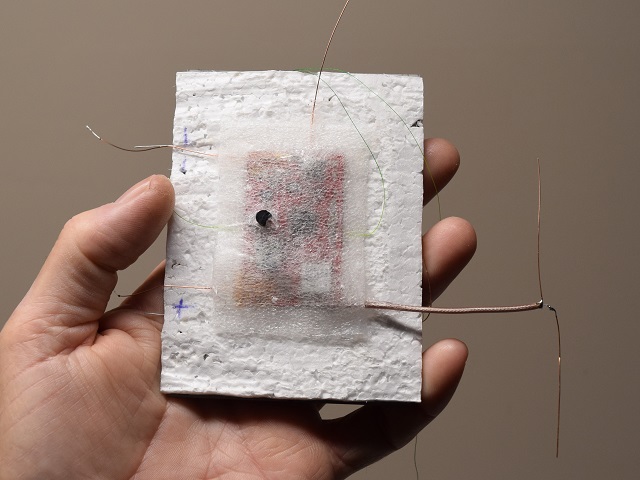
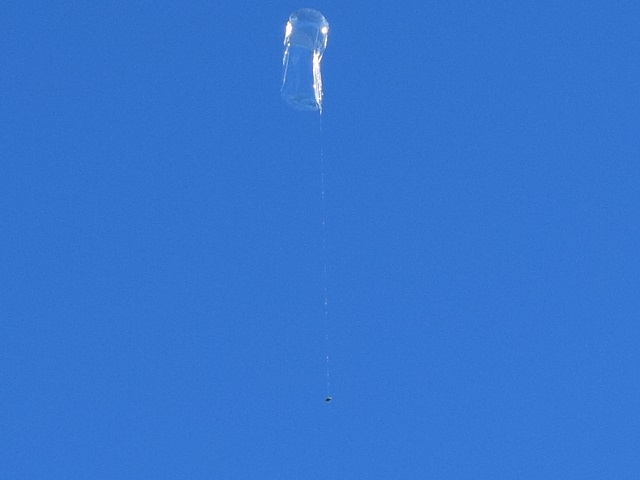
Balloon Flight BB04 information
BB04 was launched at 20:45 UTC on 10 January 2018.
Update: 04 UTC 14 Jan 2018
At about 20:30 UTC (shortly after the update below), BB04 suddenly started loosing altitude. The rate of descent was quite steady and consistent with flights by others that have suffered a burst balloon. The temperature sensor kept showing sub-zero temperatures until just before 23 UTC when BB04 stopped transmitting abruptly as it entered the cloud layer in the area. The altitude at that point was 3900m and consistent with the cloud height in the area as shown by windy.com at the time. One hour later there was a final transmission for a few minutes, no doubt as a gap in the clouds opened to let the sun on the solar cells. The transmission lasted long enough to get some final temperature and altitude data which indicated that BB04 was now quite warm (+19C) and still falling at the same rate. If the fall was due to ice build up we would have expected that ice load to be shed and the rate of descent to slow, however that was not the case, so a burst balloon was almost certainly the cause. We'll keep monitoring for BB04 for a couple of days just in case we are wrong.
Update: 20 UTC 13 Jan 2018
BB04 woke at about 17 UTC. The GPS has been working correctly so far and the tracking maps at the QRP-Labs "BB04" flight page and at Habhub are showing the progress. The Jet Stream wind in the area has picked up and BB04 is presently moving at about 110km/hr in an ESE direction. Here is the NOAA Hysplit prediction as at 19 UTC on 13 Jan 2018 (the link will expire in about 24 hours). So far the change to the 'Park Mode" parameter has been very effective with straight trails showing on the WSJT-X waterfall display.
Update: 05 UTC 13 Jan 2018
The GPS on BB04 "had a day off" today. Apparently it locked at wake up but then did not update for the rest of the day. The locator at wake up (about 19UTC on 12 Jan) was AF84TI which was close to the position predicted by the NOAA Hysplit trajectory forecast. Various reason have been offered as to why the GPS did not work today, and the next flight will have a GPS reset function in case it happens again. BB04 lost sufficient sun angle at 02:40 UTC on 13 Jan and stopped transmitting for the night.
The tracker transmitter uses modified QRP-Labs U3S firmware running on an ATmega328 with a 16 MHz clock and a nominal 3.3V supply (so working out of spec). The board is a smaller custom made PCB (thanks Mikael). This board uses a very cheap TCXO from China and a uBlox Max-7c GPS, and is flown 'naked' (no insulation). Power output is 10mW. The power supply is four 39 x 19mm solar cells powering the electonics via a 3V3 boost regulator. The antenna is a 20m dipole made from 5.26m of 0.1mm copper wire supported on 4 pound breaking strain "Dyneema" fishing line going up to the balloon, and 5.26m of 0.1mm wire dangling below the payload. The TX and solar cells weighs 5.4 grams and the whole payload with antenna weighs about 6.4 grams. This flight uses one 90cm 'party' balloon inflated to give about 5 grams of 'free lift'. The expected float altitude is around 10,000m ASL.
The telemetry transmission schedule, modes, and content is the same as for BB03 below. There is a change to the 'Park Mode' parameter in the U3S firmware to try an reduce the slight drift on the first WSPR telemetry frame.
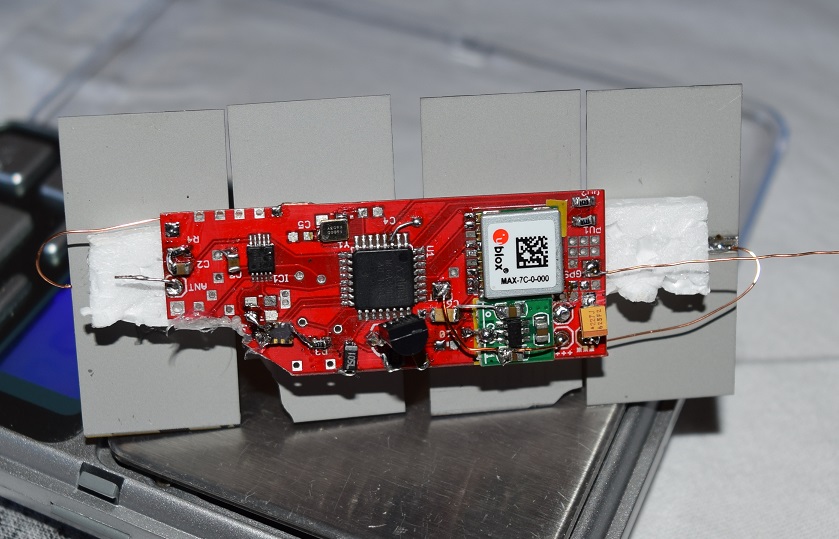
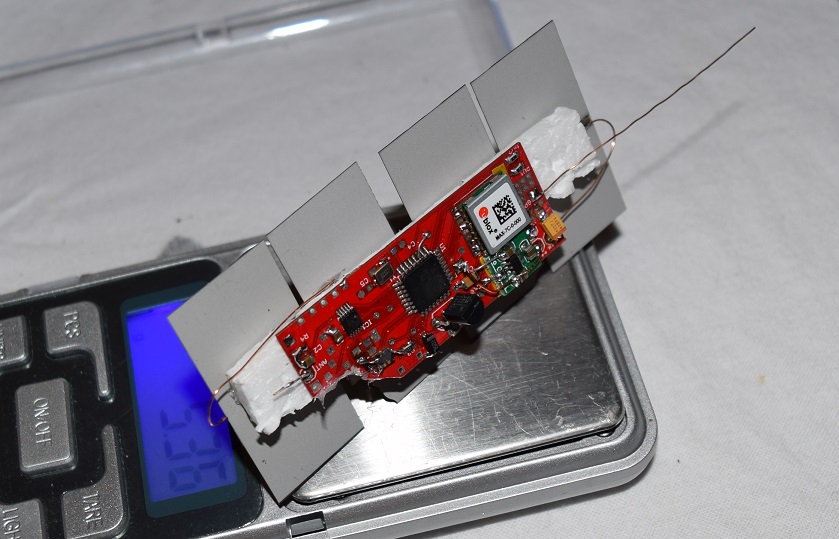
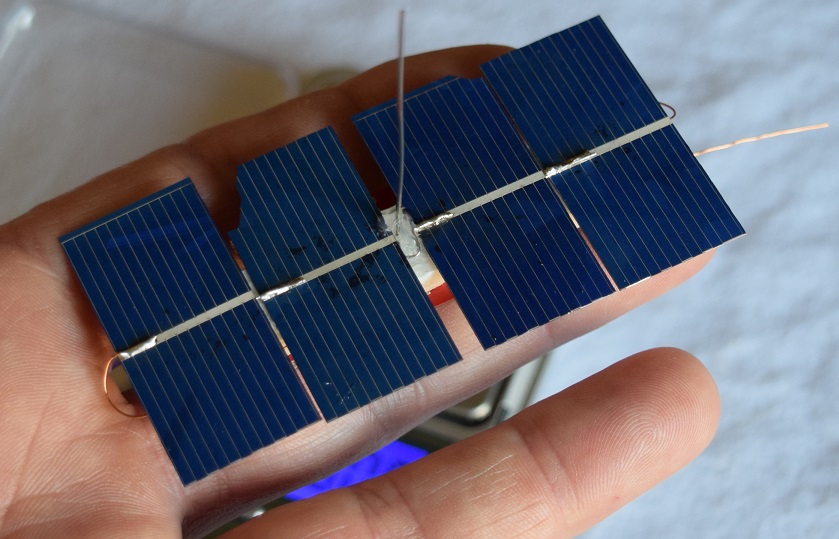
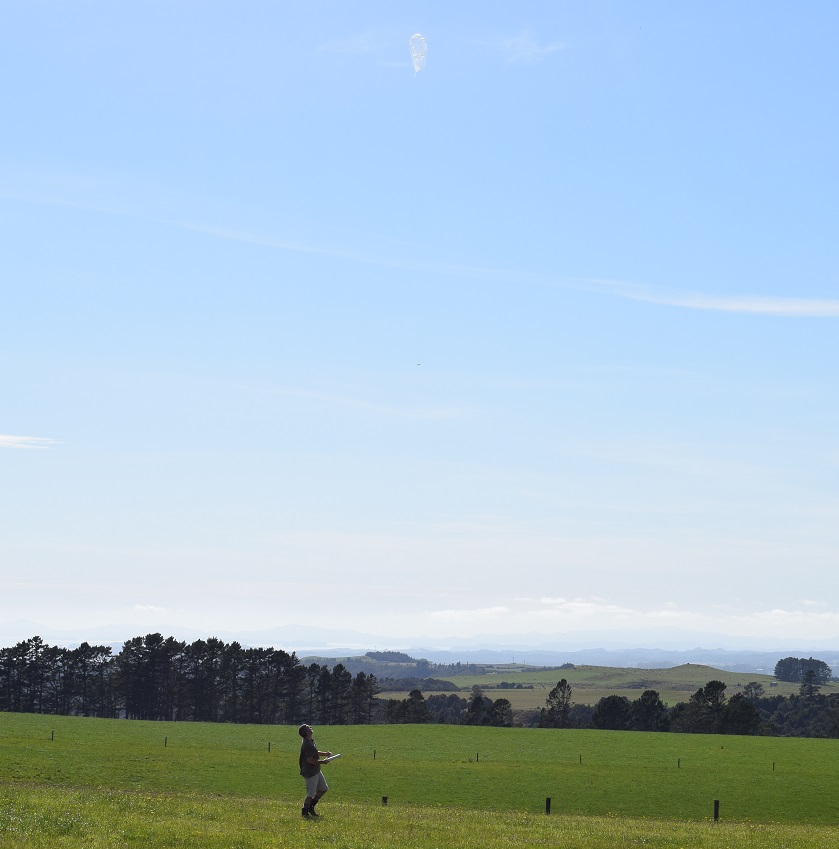
Balloon Flight BB03 information
BB03 was launched at 17:10 UTC on 07 January 2018. The GPS took a while to lock, but it seems OK now.
The tracker transmitter uses modified QRP-Labs U3S firmware running on an ATmega328 with a 16 MHz clock and a nominal 3.3V supply (so working out of spec). The board is a cut down custom made PCB (thanks Mikael). This board uses a very cheap TCXO from China and a uBlox Max-7c GPS, and is flown without any thermal insulation over the electronics except a smear of RTV over the TCXO ond Si5351a synth IC. A 2N7002 FET "power amp" has been added to provide 70mW output rather than the 10mW from the synth board alone, but the power level encoded into the special WSPR telemetry transmission is still 10dBm (0.01W) because the PA was added after the programming was done. The power supply this time is six 39 x 19mm solar cells powering the electonics directly with no regulator. The antenna is a 20m dipole made from 5.2m of 0.1mm copper wire supported on 4 pound breaking strain "Dyneema" fishing line going up to the balloon, and 5.2m of 0.1mm wire dangling below the payload. The TX and solar cells weighs 6.3 grams and the whole payload with antenna weighs about 7.5 grams. This flight uses two 90cm 'party' balloons, each is inflated with just enough gas to give about 4 grams of 'free lift' per balloon. The expected float altitude is around 10,500m ASL.
The transmitter is sending WSPR and JT9 on the 20m band in a 10 minute cycle starting on the 4th minute (QRP-Labs U3S "Frame Start" parameter = 10 04).
minute 04 & 05 - standard WSPR frame and first part of the telemetry transmission
minute 06 & 07 - encoded WSPR frame and second part of the telemetry transmission ('channel 2')
minute 08 - JT9 identification message #CS #M6
minute 09 - JT9 telemetry message #A0 #A3 #AT
minute 10 - JT9 telemetry message #GS #AT
minute 11 - JT9 telemetry message #A0 #A3 #AT
minute 12 - JT9 telemetry message #GS #AT
minute 13 - calibration (Cal Time = 10 10)
minute 14 - repeat ...
The JT9 message #CS is the callsign (ZL1RS)
The JT9 message #M6 is the 6 character Maidenhead locator as derived from the GPS module on the transmitter
The JT9 message #A0 is the temperature A-D value and will probably be in the range 090 to 220 (approx. -21 to +21C)
The JT9 message #A3 is fixed at about "747" due to no reference for the A-D conversion
The JT9 message #GS is the ground speed value from the GPS which will show as 4 characters
The JT9 message #AT is the altitude in meters above sea level from the GPS.
Typical decodes of the balloon telemetry as seen with WSJT-X and a receiver tuned to the 20m band WSPR 'dial frequency' of 14.0956 MHz (the JT9 signal can be found about 100 Hz above the WSPR signal) ...
WSPR:
1804 -22 0.6 14.097173 1 ZL1RS FF35 10
1806 -22 1.6 14.097173 0 0Q2YPT BA61 27
JT9:
1808 -24 1.3 1670 @ ZL1RS FF35SL
1809 -22 1.3 1670 @ 095 747 9711.4
1810 -22 1.4 1669 @ 42.74 9711.3
1811 -23 1.3 1669 @ 095 747 9714.7
1812 -22 1.3 1670 @ 42.85 9708.2
Thre is tracking and information at QRP-Labs - "BB03". There will also be tracking soon at Habhub and on APRS as ZL1RS-11 (thanks SM3ULC). However, the 'battery' voltage is incorrect and will not change (as explained above) and 'temperature' readings shown at those sites are incorrect due to a different A-D reference used in the telemetry decyphering software. The numbers for 'GPS lock' and 'satellite' should both read 1, meaning GPS lock = OK, and the number of satellites in the fix is 8 or more. If either reading is 0 this means the GPS is 'in trouble' and the balloon's position and altitude should not be relied on.
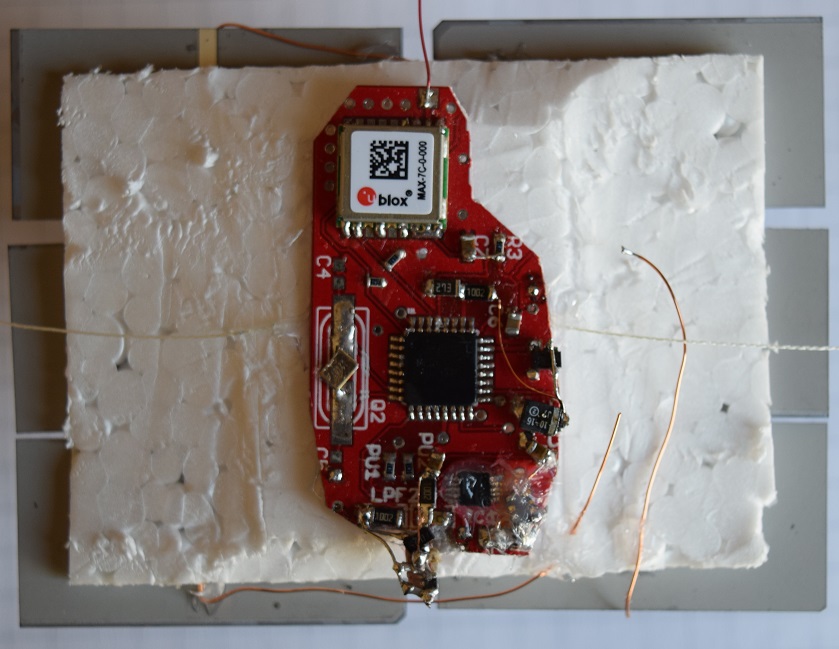
Balloon Flight BB02 information
The tracker transmitter uses modified QRP-Labs U3S firmware running on an ATmega328 with a 16 MHz clock and a 3.3V supply (so working out of spec). This time even more was cut off the QRP-Labs synthesizer kit to reduce weight! This synth board uses a very cheap TCXO from China. A BS-170 FET "power amp" has been added to provide 40mW output rather than the 10mW from the synth board alone, but the power level encoded into the WSPR transmissions is still 10dBm (0.01W) because the PA was added after the programming was done. The power supply is the same with four 52mm x 19mm solar cells producing around 2.4V in bright sun to supply the 3.3V boost regulator. The GPS is mounted upside down in 'dead bug style' where the Arduino's voltage regulator components used to be. The antenna is a 20m dipole made from 0.15mm copper wire going up to the balloon, and 0.1mm wire dangling below. The TX weighs 4.4 grams and the whole payload with solar cells and antenna weighs about 9 grams. A single 'party' balloon is inflated with just enough gas to give about 4 grams of 'free lift'.
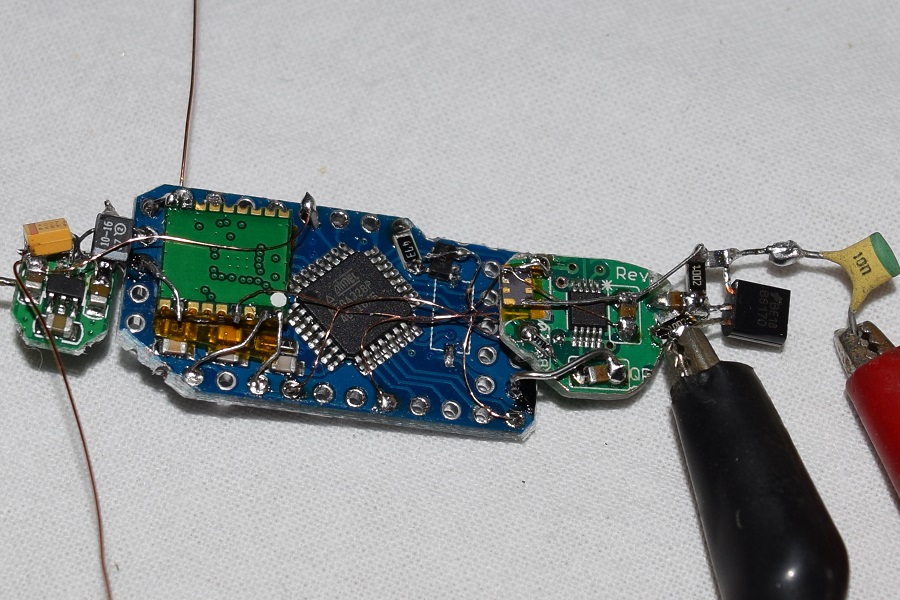
The transmitter is sending WSPR and JT9 on the 20m band in a 10 minute cycle starting on the 4th minute (QRP-Labs U3S "Frame Start" parameter = 10 04). The JT9 transmissions from BB02 have been changed since BB01 to provide more altitude information which is useful when the balloon starts dropping:
minute 04 & 05 - standard WSPR
minute 06 & 07 - encoded WSPR ('channel 0x2')
minute 08 - JT9 message #CS #M6
minute 09 - JT9 message #A0 #A3 #AT
minute 10 - JT9 message #GS #AT
minute 11 - JT9 message #A0 #A3 #AT
minute 12 - JT9 message #GS #AT
minute 13 - calibration (Cal Time = 10 10)
minute 14 - repeat ...
The JT9 message #CS is the callsign (ZL1RS)
The JT9 message #M6 is the 6 character Maidenhead locator as derived from the GPS module on the transmitter
The JT9 message #A0 is the real temperature A-D value and will probably be in the range 090 to 220 (approx. -21 to +21C)
The JT9 message #A3 is the real solar cell A-D value and will probably be in the range 620 to 760 (approx 2.00 to 2.45V)
The JT9 message #GS is the ground speed value from the GPS which will show as 4 characters
The JT9 message #AT is the altitude in meters above sea level from the GPS.
Typical decodes as seen with WSJT-X and a receiver tuned to the 20m band WSPR 'dial frequency' of 14.0956 MHz (the JT9 signal can be found about 100 Hz above the WSPR signal) ...
WSPR:
1804 -22 0.6 14.097173 1 ZL1RS FF35 10
1806 -22 1.6 14.097173 0 0Q2YPT BA61 27
JT9:
1808 -24 1.3 1670 @ ZL1RS FF35SL
1809 -22 1.3 1670 @ 095 731 9711.
1810 -22 1.4 1669 @ 42.74 9711.3
1811 -23 1.3 1669 @ 095 745 9714.
1812 -22 1.3 1670 @ 42.85 9708.2
As well as the map at QRP-Labs - "BB02", there is also tracking at Habhub and on APRS as ZL1RS-11 (thanks SM3ULC). However, the 'battery' voltage and 'temperature' readings shown at those sites are incorrect due to a different A-D reference used in the telemetry decyphering software. The numbers for 'GPS lock' and 'satellite' should both read 1, meaning GPS lock = OK, and the number of satellites in the fix is 8 or more. If either reading is 0 this means the GPS is 'in trouble' and the balloon's position and altitude should not be relied on.
Conversion table for Temperature (A-D A0 telemetry) and Solar Voltage (A-D A3 telemetry) that is sent via JT9 transmissions.

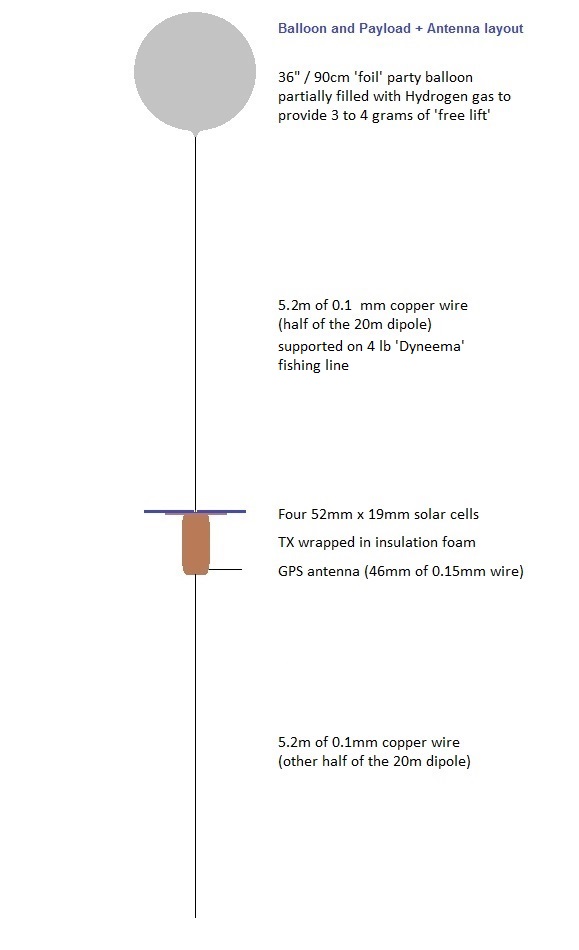
Balloon, antenna and transmitter configuration concept.
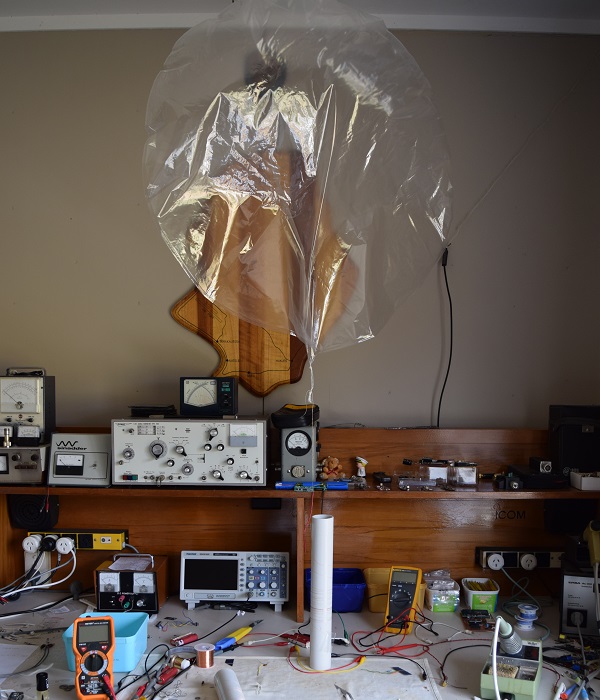
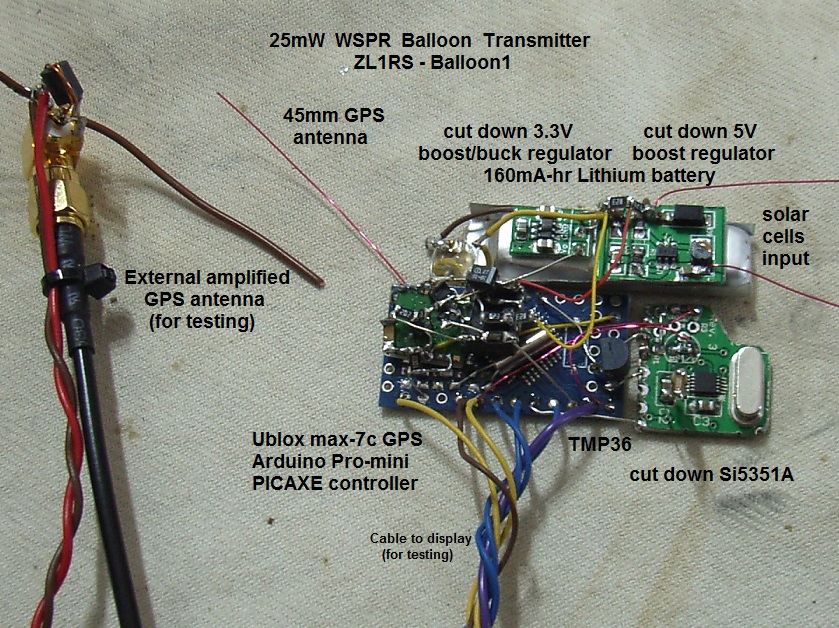
Prototype HF telemetry balloon transmitter version 1 - approximately 15 grams plus antenna and solar cells. Not flown, too heavy.
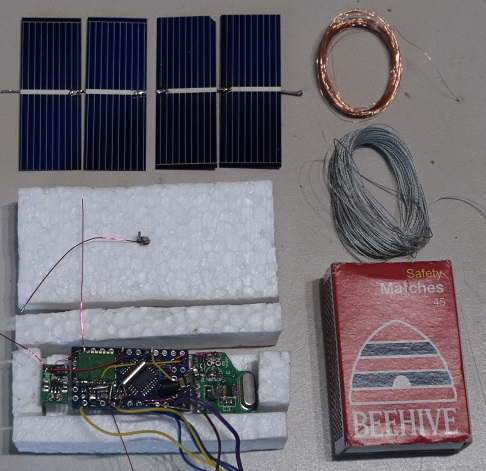
Prototype version 2 (without the PICAXE controller, battery and boost regulator) - approximately 8.5 grams plus antenna and solar cells. Destoyed at launch due to a gust of wind.
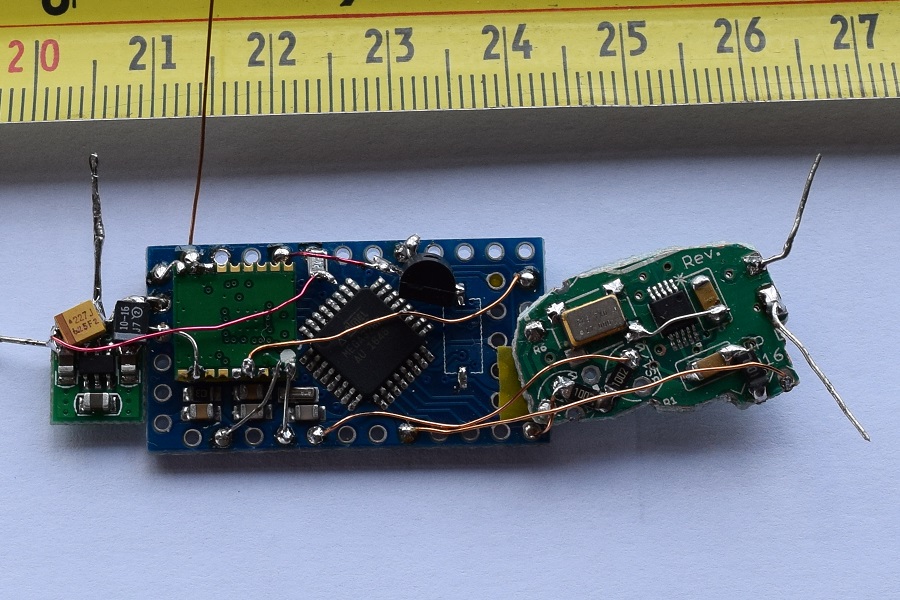
Version 3 as used on ZL1RS balloon flight "BB01" - approximately 8 grams plus antenna and solar cells.

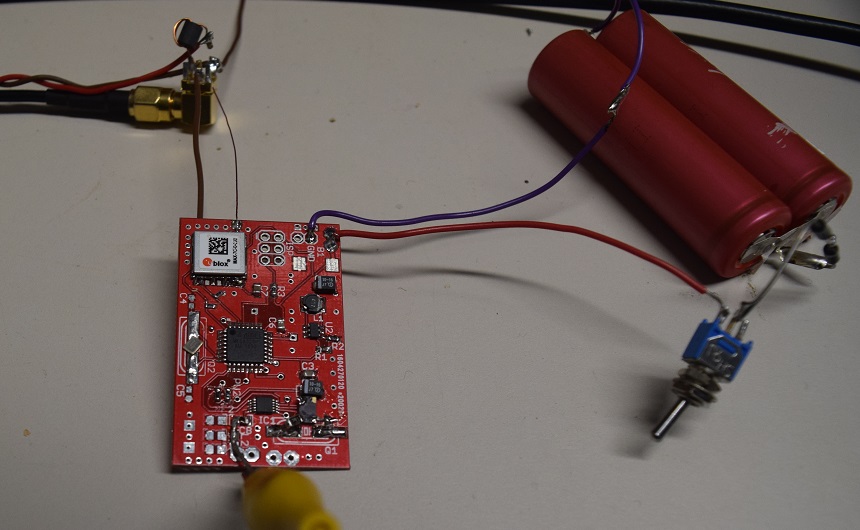
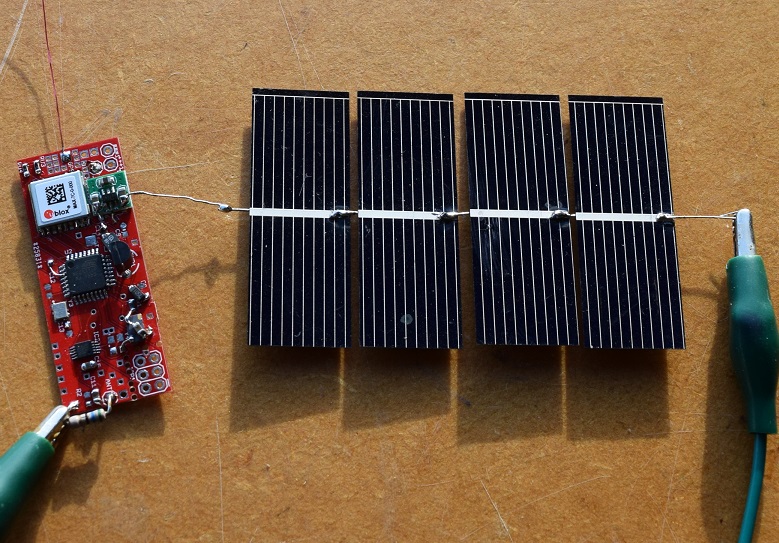
|
















